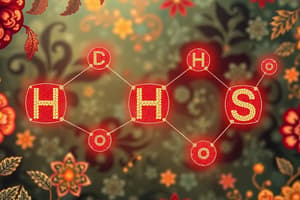Podcast
Questions and Answers
How many valence electrons does an atom of Selenium (Se) possess?
How many valence electrons does an atom of Selenium (Se) possess?
- 8
- 6 (correct)
- 2
- 4
Which of the following correctly represents the Lewis dot notation for a neutral phosphorus (P) atom?
Which of the following correctly represents the Lewis dot notation for a neutral phosphorus (P) atom?
- :P:•
- • P •• (correct)
- •P:
- •P•
Which of the following ionic compounds has the correct Lewis dot structure?
Which of the following ionic compounds has the correct Lewis dot structure?
- Li⁺ [ : F : ]⁻ (correct)
- Ca⁺ [ : Cl : ]₂⁻
- K⁺₂ [ : S : ]⁻²
- [ Al ]⁺³ [ : N : ]⁻³
Based on electronegativity trends, arrange the following elements in order of increasing electronegativity: Te, Se, S, Po
Based on electronegativity trends, arrange the following elements in order of increasing electronegativity: Te, Se, S, Po
Given the electronegativity values: H=2.1, Cl=3.0, I=2.5; Which of the bonds is the most polar?
Given the electronegativity values: H=2.1, Cl=3.0, I=2.5; Which of the bonds is the most polar?
Flashcards
What are valence electrons?
What are valence electrons?
Valence electrons represent the outermost electrons in an atom, and they are responsible for forming chemical bonds.
What is Lewis dot notation?
What is Lewis dot notation?
Lewis dot notation represents the valence electrons of an atom as dots around the atom's symbol. Each dot represents one valence electron.
What is electronegativity?
What is electronegativity?
Electronegativity is the ability of an atom to attract electrons towards itself in a chemical bond. Higher electronegativity values indicate stronger attraction.
What is a non-polar covalent bond?
What is a non-polar covalent bond?
Signup and view all the flashcards
What is an ionic bond?
What is an ionic bond?
Signup and view all the flashcards
Study Notes
Chemical Bonding
-
Valence Electrons:
- Cs has 1 valence electron
- Se has 6 valence electrons
- I has 7 valence electrons
- Ca has 2 valence electrons
-
Lewis Dot Notation (Elements):
- K: •K•
- P: •P•
- Cl: •Cl•
- B: •B•
- Br: •Br•
-
Lewis Dot Notation (Ions):
- Cs⁺: [ ]
- Sr²⁺: [ ]
- Si⁴⁺: [ ]
- As³⁻: [ ]
- Te²⁻: [ ]
- I⁻: •I•
-
Lewis Dot Structures (Compounds):
- LiF: Li⁺[ ] F⁻[ ]
- K₂S: 2K⁺[ ] S²⁻[ ]
- AlN: Al³⁺[ ] N³⁻[ ]
- CaCl₂: Ca²⁺[ ] 2Cl⁻[ ]
- Al₄C₃: 4Al³⁺[ ] 3C⁴⁻[ ]
- GaCl₃: Ga³⁺[ ] 3Cl⁻[ ]
- MgO: Mg²⁺[ ] O²⁻[ ]
- BeI₂: Be²⁺[ ] 2I⁻ [ ]
- KI: K⁺[ ] I⁻[ ]
- Mg₃N₂: 3Mg²⁺[ ] 2N³⁻[ ]
-
Electronegativity Order (increasing):
- Po, Te, Se, S
- Al, P, S, F
- B, C, N, O
-
Bond Types:
- Non-polar: identical atoms
- Polar: atoms with different electronegativity
- Ionic: large electronegativity difference
-
Most and Least Polar Bonds:
- Most Polar: H-F
- Least Polar: H-H
Studying That Suits You
Use AI to generate personalized quizzes and flashcards to suit your learning preferences.




